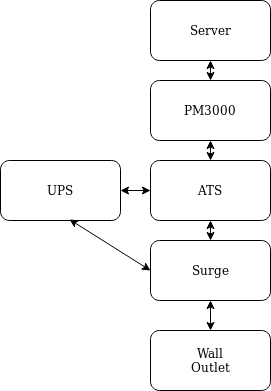So here is the issue:
- I want a PDU that lets me powercycle individual devices.
- I want a PDU that tracks power usage for individual devices.
- I want my main devices to be on UPS power.
- I want to be able to swap/repair UPS's without taking half the network down.
- If a UPS dies (like they do all the stupid time), if the power is up, don't drop everything connected.
Over the past 10 years, I've had maybe 5-6 power events. But more often than that, I've had UPS events. Perfectly fine UPS, or maybe a UPS whose battery is dying, decides "hey, lets power down hard, and refuse to power back on, even though we are plugged into a perfectly good wall." Then mad scrambling and powerstrips result.
I am all done.
So lets go over how to fix this, step by step.
First, we need a UPS. That's easy, anything but tripplite. Well, I already have some, so, ehh..
Second, what we want is a MBS. Maintenance bypass switch. This is a little manual switch, that lets you switch the incoming power seamlessly from a UPS to mains. This lets you repair the stupid UPS, without taking a hit. But what if the UPS just goes at 3am? Then you have to run over there and flip the stupid switch. That sux.
So instead, what you really want, is an ATS. An Automatic Transfer Switch. Except, these aren't meant to do this. What they are designed for, is you having 2 power circuits, and if one dies, it flips to the other feed. I'm not fancy enough to have that, and if the mains went out, all the circuits would be down anyway, so it's pointless. If you go read the docs on the Cyberpower model, they say "don't you dare plug both lines into the same feed jackass." But it turns out, Tripplite says something different.
Tripplite PDUMHAT15. The manual straight up says, you can plug the primary into the wall, the secondary into a UPS, and then that UPS right into the same wall, and it's OK. Given my history with TrippLite, I was pretty hesitant. But I got one off ebay for about $120, and thought, ok, lets find out.
Plug primary into powerstrip, plug powerstrip into wall. Plug secondary into UPS. Plug secondary into a power strip, plug powerstrip into wall. Plug a random computer into the ATS. Flip off the switch on the primary powerstrip. Beeps, computer keeps running, it's running off the UPS (which is still on mains). Flip off the secondary, UPS takes over, it's all happy. Try all the stupid combinations. It just works. The computer attached kept running the whole time.
So here is the layout then:

What is a PM3000 you ask? Well that's a cheap PDU you can get off eBay, for about $80 a pop, that gives you full networked control over each individual outlet, as well as full power stats on each individual outlet (watts, volts, vA, amps, etc). In other words, a full blown high end PDU, for next to nothing. And they are really good.
So now, UPS dies, I get an email. I want to know the vA load on the UPS, I go look at the pm3000. Everything is plugged into a high end surge surpressor, so if I take a lightning hit, I'm less sad.
Currently I have 3 of these stacks setup. 2 on my main compute rack for the proxmox clusters and other servers, and one on my network rack for the main switch, pfSense firewall, and DSL lines.
I have near-datacenter quality power. Obviously if there is an extended outage, I'm down, but I won't have any more stupid UPS hits, and that is worth the price of admission. Total cost for this stack:
- Surge: CyberPower CPS-1215RMS $50
- ATS: PDUMHAT15 $120
- UPS: Varies, lets say $300
- PM3000: $80
- Total: $550 per stack.
Not bad. Most of that is the UPS. $250 w/o UPS.
I can has joy.